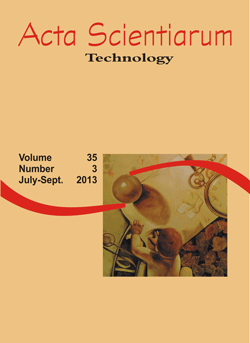<b>Biological systems combined for the treatment of coffee processing wastewater: II - Removal of nutrients and phenolic compounds</b> - doi: 10.4025/actascitechnol.v35i3.13628
DOI:
https://doi.org/10.4025/actascitechnol.v35i3.13628Keywords:
anaerobic reactor, constructed wetland systems, phenols, nitrogen, phosphorus, coffeeAbstract
Three treatment systems consisting of anaerobic filters with upward flow followed by constructed wetland systems (CW) were evaluated for the removal of nutrients and phenolic compounds, in the treatment of coffee processing wastewater (WCP) in Viçosa, Minas Gerais State. Filters were made of PVC (1.5 m high and 0.35 m diameter) filled with gravel # 2 and CW were made of wooden boxes (1.5 m long, 0.4 m high and 0.5 m wide) sealed by HDPE geomembrane and filled with gravel `zero´. The WCP had the pH adjusted with lime to values close to 7.0 and the nutrient concentration changed to obtain a BOD/N/P ratio of 100/5/1. As a result, hydraulic retention times longer than 160 h in all treatment systems during phase III had not promoted greater efficiencies for removal compared with the phase I, because the recovery time of the systems was inadequate. The F1+CW1 system that received the lowest organic load, showed a satisfactory performance with regard to the removal of nutrients (above 50%).
Â
Downloads
Downloads
Published
How to Cite
Issue
Section
License
DECLARATION OF ORIGINALITY AND COPYRIGHTS
I Declare that current article is original and has not been submitted for publication, in part or in whole, to any other national or international journal.
The copyrights belong exclusively to the authors. Published content is licensed under Creative Commons Attribution 4.0 (CC BY 4.0) guidelines, which allows sharing (copy and distribution of the material in any medium or format) and adaptation (remix, transform, and build upon the material) for any purpose, even commercially, under the terms of attribution.
Read this link for further information on how to use CC BY 4.0 properly.











8.png)




